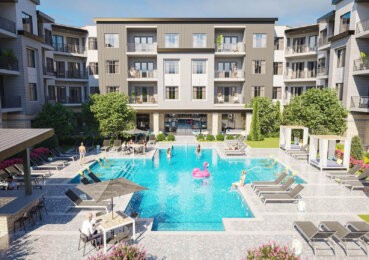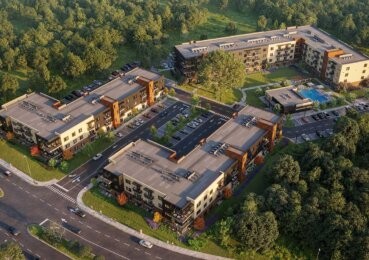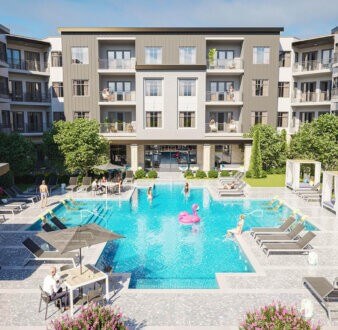A successful relationship between developers and architects must feature collaboration. DKLEVY President Daniel Levy is joined by Solinity Founder and CEO Josh Crisp to discuss seniors housing trends, partnerships, and design.
This conversation was recorded at the 2024 LeadingAge Annual Conference.
What brings you to LeadingAge in Nashville, and how does it feel to be here?
Josh: It’s great to be here at LeadingAge, Nashville, and even better to be sitting down with you, Daniel. Events like this are energizing. You see thought leaders, product innovators, and service providers all coming together with a common goal. It’s a chance to rejuvenate and exchange ideas that push the senior living industry forward.
The senior living sector has faced significant challenges in recent years. How would you describe the current state of the industry?
Josh: It’s been tough—several hard years since COVID. While census numbers are improving, staffing remains a significant challenge. Development has slowed dramatically, but this has opened opportunities to breathe new life into existing assets through renovations and redevelopments. We’ve been fortunate to work on acquisition and redevelopment projects that give older communities a fresh start.
The demand for housing and services continues to grow as the aging population expands, which presents both a responsibility and an opportunity for our industry. The next few years will be pivotal as we address these challenges and embrace innovation.
What do you think is preventing the industry from breaking through the current challenges and fully meeting the growing demand?
Josh: It’s complex. Economically, there are factors beyond our control. Additionally, consumer preferences are evolving. For decades, we’ve served the Greatest Generation, but now we’re preparing for Baby Boomers. Their preferences, affordability needs, and expectations are drastically different.
Technology is also reshaping how we deliver services, forcing us to rethink our offerings and amenities. Change is never easy, but it’s a necessary step to meet the needs of this new generation.
Another significant factor is rising acuity levels since 2008, particularly in assisted living. However, regulations haven’t evolved to match these changes. Many state regulations are outdated—some haven’t been revisited in 15–20 years. This creates challenges when trying to implement innovative solutions, like the forward-thinking designs your team creates. The regulatory environment needs to adapt to enable operators to bring these creative ideas to life.
How can the industry overcome these obstacles?
Josh: Advocacy is key. Organizations like LeadingAge play a crucial role in lobbying at both state and federal levels to drive legislative change. We don’t necessarily need more regulations, but we need to modernize existing ones to reflect today’s realities.
Events like LeadingAge are also essential. They highlight innovative products, housing solutions, and services that can transform our industry. As we address economic challenges, embrace new technology, and advocate for updated regulations, we’ll be better positioned to serve the growing aging population.
What excites you most about the future of senior living?
Josh: I’m excited to see how the industry evolves in the coming years. The aging population’s demand for housing and services will only grow, and with it comes the opportunity to innovate. From new development to reimagined spaces in existing communities, the potential to make a meaningful impact is enormous. It’s a challenging but exciting time to be in senior living.
How do you approach tailoring senior living communities to local markets and identities?
Josh: It all comes down to embracing what’s local. More people are looking for unique experiences that resonate with them personally. While our industry has traditionally excelled in providing care, people now want more—care within an environment that feels personal and connected to their community.
For example, in Nashville, we might include a music studio because it fits the cultural identity. Meanwhile, in North Carolina, we might opt for a woodshop. It’s about creating amenity spaces that reflect the local culture while staying mindful of affordability. Cookie-cutter designs are a thing of the past. Today, developers, architects, and operators need to work together early in the planning process to create thoughtful, intentional spaces that meet the needs of both the market and the residents.
What role does affordability play in senior living development?
Josh: Affordability is more critical than ever. Our approach, like with our Hometown Portfolio, focuses on delivering quality care and amenities that are accessible and affordable for our target markets. Not everyone wants—or can afford—a resort-like senior living environment. Many want to stay in the community where they’ve lived their entire lives.
The challenge lies in balancing high-quality care with cost-effective solutions. Building a “vanilla box” over and over is no longer sustainable. Instead, we must analyze each market to design spaces that meet specific needs, both functionally and financially.
How is technology impacting senior living, and what are the main concerns?
Josh: Technology is evolving rapidly, and while it offers incredible tools, it can also overwhelm staff and residents if not implemented thoughtfully. I’ve seen communities where too many unconnected apps and systems create frustration for caregivers, detracting from actual care delivery.
Operators need to focus on simplicity and integration. What data do we need? What are the KPIs? How can we streamline systems to equip staff and improve resident outcomes? And just as important, operators need buy-in from the entire team using the technology.
For residents and families, the primary concerns center on safety and communication. Families want to know their loved ones are safe, whether through fall prevention tools, secure access systems, or transparent communication platforms. They also want to stay connected—whether that’s video calls or being part of the care team. The goal is to use technology to build trust and enhance the resident and family experience.
What are families and residents asking for when it comes to technology?
Josh: The key asks are safety, transparency, and communication. Families want to know their loved ones are safe from falls, that the community itself is secure, and that they can stay informed and involved in care decisions.
For example, tools that track who enters and exits the building or systems that alert staff to potential falls in resident rooms are increasingly in demand. At the same time, families want communication tools that give them visibility into their loved one’s care, reducing the guilt they often feel when they can’t be present every day.
How can architects better support the aging-in-place model?
Josh: Architects play a crucial role in making senior living communities functional and forward-thinking. For example, they need to ensure the building design accommodates operational needs, from life safety codes to service flow. Partnering with architects deeply familiar with senior living is key—they should know the industry as well as the operators do.
When architects attend industry expos, stay up to date on technology, and understand the nuances of senior living, the process becomes much smoother. This knowledge reduces time, saves costs, and ultimately results in better designs that serve residents, staff, and operators alike.
What’s the value of involving operators early in the development process?
Josh: Bringing operators to the table from day one is critical. Senior living is a unique vertical—it’s not just about building a property. Operations include full-time restaurants, maintenance, housekeeping, clinical services, medical coordination, and transportation. All these functions depend on the design of the building.
When operators are involved early, they can provide insights into everything from regulatory requirements to staffing challenges. This partnership leads to better outcomes for the residents, the staff, and the building’s financial success. Even if the plan is to sell the property in a few years, involving an experienced operator early on increases the property’s value.
How can senior living communities differentiate themselves in tertiary markets?
Josh: Differentiation starts with understanding the local market. In smaller or tertiary markets, it’s not just about location anymore. It’s about creating a sense of community and offering amenities that align with what residents and their families value.
Whether you’re updating an existing building or developing a new one, the key is thoughtful planning and collaboration with architects, operators, and local stakeholders. The days of relying solely on location or a one-size-fits-all approach are over. Every community needs a unique identity that reflects its residents and surroundings.
How do you decide which amenities to include in senior living communities?
Daniel: Sometimes, it’s as simple as asking: What are the spaces we enjoy being in? We focus on designing environments that blur the lines between senior living spaces and family-oriented spaces. For instance, a bingo room shouldn’t feel like one—it could double as a coffee shop, a bistro, or even a workspace where residents and families can gather comfortably.
The bigger challenge, though, is affordability. Rising construction costs and financial constraints push us to think creatively about dual-purpose spaces and leveraging amenities already present in the community. Josh, what’s your take on balancing affordability and amenities?
Josh: It depends on the market and whether it’s a new build or an existing structure. One trend I’ve noticed is the monetization of amenity spaces. For instance, in urban settings, retail storefronts can be integrated into the senior living community, serving both residents and the greater public through memberships or walk-in services. This approach brings in additional revenue and creates a multi-generational experience.
Additionally, we’re seeing more partnerships with outside providers who lease space within senior living communities. Not only is this cost-effective compared to traditional retail leases, but it also aligns with resident needs and fosters community interaction. It’s about creating spaces that allow residents to remain part of the broader community, enhancing their quality of life while supporting the financial health of the property.
How can senior living communities benefit from bringing in outside users for amenity spaces?
Daniel: Think about hotels—many generate revenue from restaurants, coffee shops, and bistro bars that attract people who aren’t staying at the hotel. If those spaces were reserved exclusively for guests, they’d lose out on valuable income.
Josh: Exactly. For senior living owners, the same principle applies. If we diversify revenue streams beyond room and board, we can better penetrate the middle market. Amenities like cafés or fitness centers that serve both residents and the surrounding community help reduce reliance on traditional pricing models, making communities more accessible and sustainable.
For more insights on senior living design, affordability, and multi-generational innovation, connect with DKLEVY.








